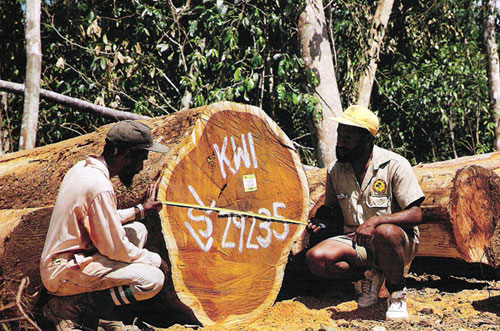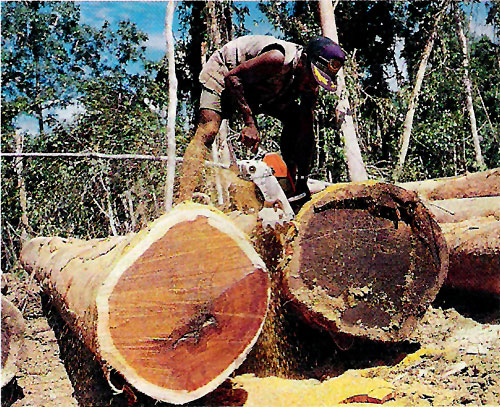| BUILDING A SUSTAINABLE RESOURCE BASE FOR PNG
At a recent conference in Lae titled “Building Partnerships for the Future” the Director of the National Planning Office, Kila Ai, said that ‘it was hard to see how, even with PNG’s abundant resources, the country could sustain its mounting population with a standard of living that was acceptable’. That PNG currently enjoys abundant natural resources is not in doubt but what of the future? What impact will a growing population have on our resources and sustainable development?
The Director of the Institute of National Affairs, John Millet, in a recent paper focused on the future of the forest industry in PNG and particularly the sustainability of the forest resource base, one of our greatest natural resources.
His concluding words “whether or not the logging rate I sustainable is not the central issue, the absence of a clear land use strategy is”, very clearly states the major problem to be overcome in PNG is to have a sustainable timber industry. This problem needs to be addressed both promptly and directly before any discussion of the correctness or otherwise of “the numbers” associated with long term forest management.
The very foundation of a sustainable timber industry is the dedication of a secure resource base. This requires the allocation of land that will be given over for long periods of time, the very minimum would be 80 years, for the purpose of growing timber. It would then be necessary to determine a suitable management plan for these dedicated areas which takes inot account the natural growth rate of the forest, whether this rate can be increased by the application of silvicultural techniques and the impact of harvesting on remaining stands.

Present policy limits the timber harvest each year to one thirty fifth of the timber resource in an area
Before such dedicated areas could be defined, it would be necessary to also determine what areas should be set aside for agricultural and subsistence farming use, for industrial and urban development, and areas to be preserved for conservation protection areas.
In PNG there are no areas of natural forest currently dedicated or zoned as permanent timber growing areas. Land, and the forest growing on it, is privately owned by the traditional landowners.
The Government can not, and currently lacks any legal right to, direct private (customary) land use through any term of zoning. For the foreseeable future it will be the traditional landowners themselves that must take the lead In setting aside land for sustainable forest management.
Traditional landowners firstly need to be educated as to the benefits of sustainable forest management. This would require a major shift in focus from the short term, immediate development” outlook so prevalent today, to one of long term, steady progress.
Secondly, landowners need to make the commitment of their land in large enough areas to support a sustained forest industry. Under existing laws this could be achieved by registering customary land and then entering into an appropriate joint venture with a forest management developer.
Such a scenario is envisaged in the new Forest Management Agreement system which has replaced the Timber Rights Purchase document as the main vehicle for forest utilization and management.
Unfortunately, the current frame work of the FM.A. does not go far enough to guarantee long term resource management and sustainability of the resource base.
Long term management
As a minimum there should be a requirement to permanently set aside areas tar long term management through agreement by the resource owners to a designated forest management concept for the area; such areas need to be of a size that will ensure repeated timber harvesting into the future and, if the area is suitable, to support the large scale donwnstream processing plants that are envisaged under the new forest policy.
Present policy limits the timber harvest each year to one thirty fifth of the timber resource in an area- The policy assumes that thirty five years after the first harvest, the land wilt still be avail able for logging and that the natural forest will have regrown, to at least its original composition and or value under a management policy of benign neglect.
This is a very doubtful foundation on which to build the future of the timber industry.
The assumption that the land area initially producing the harvest log volume will remain untouched after 35 years is extravagancy optimistic It is obvious that over that period of time large areas ot forest will be converted to other uses - agriculture, subsistence and commercial, will account for the largest conversion This will be the natural result of increasing population pressure on the land.
PNGs population now is estimated at about four million, and at current growth rates it is forecast to approach 7.5 million by the year 2030, the end of the first 35 year logging cycle. By the year 2100, the end of the third logging cycle, the population will approach 47 million if the cur rent growth rate is maintained.
In one of the few studies conducted into population growth and land use in PNG, the Food and Agriculture Organization of the United Nations, indicated that an extra 1.5 hectares of land is needed for each additional person dependent upon subsistence agriculture.

Three and a half million more people, each requiring one and a half hectares would result in more than five million hectares of forest being cleared, in addition to the land already being used for agricultural purposes, by the year 2030. By year 2100, virtually all available forest would have been cleared for that pur pose if unregulated.
In the immediate future it is more than likely that most of this land clearing will take place on land that is the most suit able for long term forest management: primarily flat or moderately hilly, certain ly less than the 30 degrees maximum ground slope on which current logging is allowed.
Indeed, it was a general conclusion of the F.A.O. report that in areas where it could be foreseen that alternate land uses would result in the loss of the natural forest, the rate of logging should be increased. This would capture at least some economic benefit from forest before it is felled to waste.
One needs only to look around the now sparse bushland surrounding Port Moresby and other urban centers to appreciate the impact that uncontrolled land clearing for subsistence purposes has on the remaining forest
The existing land area under some form of forest management, either Timber Rights Purchase or Forest Management Agreement, is approximately six million hectares. This may expand slightly over the next 30 to 40 years to six and half to seven million hectares.
Taking into account that, on average, 25 per cent of any timber area is inoperable i.e. unloggable, because of ground slope, waterway protection zones, vii ages and other developments within the timber area etc. the real maximum potential area available for long term for est management is estimated at approximately five million hectares.
How much of this area will be “lost” to agricultural and other developmental land clearing is uncertain. It would be reasonable to assume that as living standards improve there will be less reliance on subsistence agriculture. It is impossible to say however, how this may result in the forest being protected from land clearing. Improving living standards brings other types of developments - urban expansion, more roads etc. and significantly, a greater demand for forest products.
At this time we can only take the view that until traditional landowners, with Government support and guidance, dedicate large areas of natural forest to long term sustainable forest management, the future of the natural forest as a resource base for a sustainable timber industry is under threat.
The mechanism could be developed under the Forest Management Agreement, and they have yet to evolve.
Growing pressure from non-industry participants may eventually lead to landowners and Government having to address the problem of long term land use planning. There is little evidence of this happening now; in PNG land mailers have been put in the ‘too hard basket.
However one thing is certain, the problem will not go away.
Reprinted from PNG RESOURCES Magazine
|